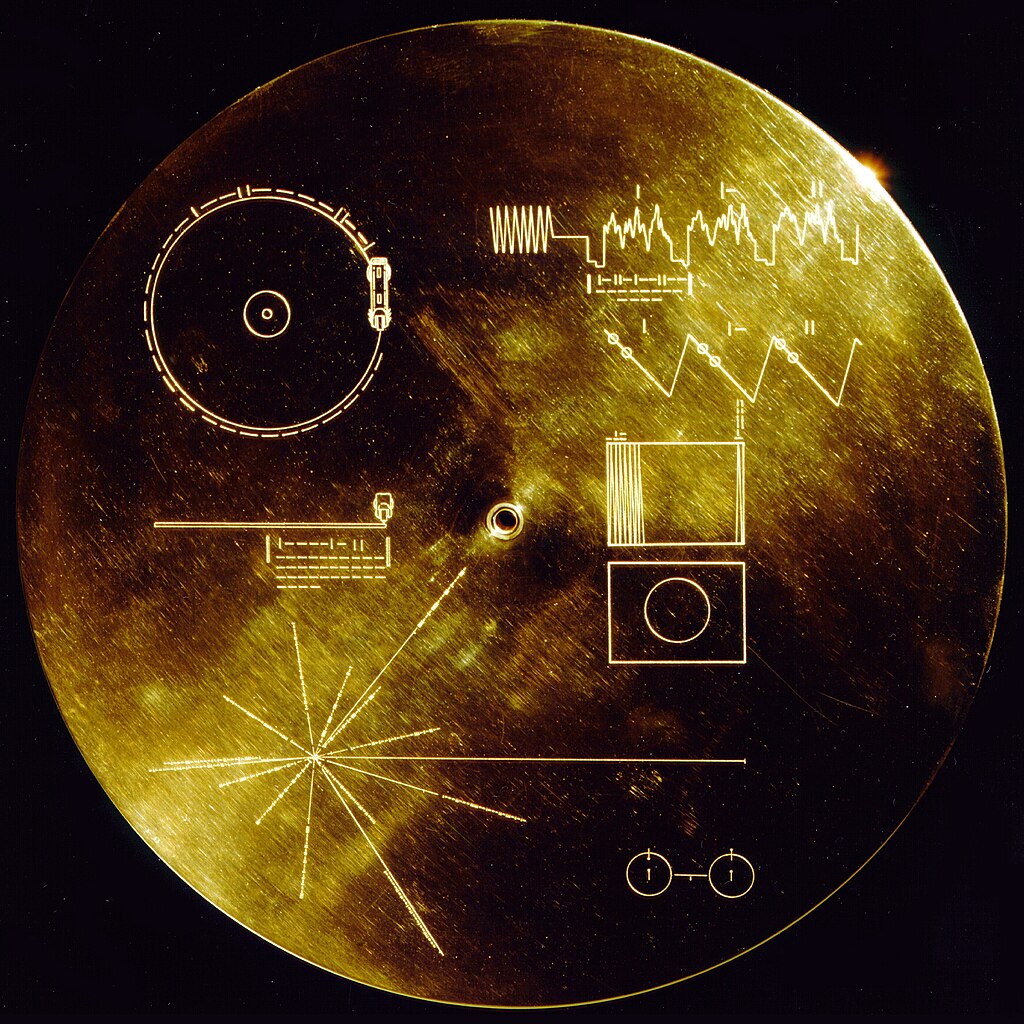An overarching set of criteria I had when consolidating the songs on the Golden Record down to 10 songs was one of redundancy and quality of recording. Upon first look there are 7 classical music-genre tracks in the list of 25 which I felt could be paired down to avoid over-representation of one specific culture/genre. There were also several tracks I would have liked to include but were eliminated due to the quality of the sound recording – if possible to re-record some tracks, I may have changed my answers.

The Sounds of Earth Record Cover, 4 September 1977. NASA/JPL. https://commons.wikimedia.org/wiki/File:The_Sounds_of_Earth_Record_Cover_-_GPN-2000-001978.jpg
Percussion (Senegal)
I felt this was a worthy inclusion as it felt like an example of humanity’s enduring proclivity for music. This song comes across timeless in the sense that it could be played in a similar fashion regardless of time period. I felt this resonated with me along with Rumsey’s statement in this week’s video where astronomers are engaged in the study of history. The sheer fact that our observation of space is one of looking into the distant past meshes with this perception of ‘enduring timelessness’ that I felt was matched by this song.
Johnny B. Goode
While going through the tracks I reflected upon the historical underappreciation of African-American contributions to space travel, inspiring stories such as “Hidden Figures”. I felt it would be fitting to add a track by a true African-American pioneer and trailblazer to the collection carried by humanity’s own interstellar pioneer. I feel this song also helps to communicate the human spirit of energy, creativity, and innovation.
Tsuru No Sugomori (Crane’s Nest)
I felt this song to be very appropriate as it depicts the life cycle of cranes which includes the building of a nest, laying an egg, and raising a chick to where it leaves the nest with the bittersweet farewell that entails. I certainly do trend towards the anthropomorphizing of the Voyager probes which influences my decision for this track. Due to this tendency, I found it fitting to reflect the similarity between the cranes releasing their young into the great unknown and humanity sending these probes into the void.
The Magic Flute (Queen of the Night Aria)
This one definitely has bias inherent in it as this is one of my favourite songs but I do believe it also has a place on the record as it remains one of the more challenging soprano pieces in classic operas. I felt this would be a fitting testament of the range and ability of the human voice as it spans multiple octaves which isn’t present to the same extent as the other tracks.
Melancholy Blues
My first runthrough had me trying to choose between Melancholy Blues and Johnny B. Goode and I was going to eliminate this choice. Listening to the podcast attached to this week however changed my mind as I found the description in Twenty Thousand Hertz particularly poignant as they mention the bittersweet nature of a lonely travelling probe millions of kilometers from Earth carrying with it this song. This is however my least sure choice of the 10.
Fifth Symphony (First Movement)
Again my own bias comes into this as I believe it has to when choosing from the many classical pieces. They are all representative of masters in their field and, lacking any deeper knowledge to quantifiably distinguish between them, I made my choices based on my own emotional responses and enjoyment of them as (one could argue) all humans do with pieces of art. A secondary reason behind my choice of this piece was to highlight the ability of humans to overcome adversity and/or disability where this incredibly powerful piece was created by an individual rapidly losing their ability to hear.
Night Chant
This one I would love to include a re-recorded version to improve the quality! I felt it was important to acknowledge the Indigenous peoples and was torn between this song and the Morning Star and Devil bird and opted to go for the song from the country that fired Voyager into space. This is built upon so many layers of bias which is incredibly unfair which I believe is unavoidable when trying to choose only 10 songs to represent the vastness of humanity’s capabilities, creativity, and cultures.
Panpipes (Solomon Islands)
The panpipes I chose for similar reasons to the Senegal percussion track as this has a timeless quality where this could be played in and represent nearly any stage of human history. I wished to include this track as well to demonstrate a different style of instrument from percussive.
Flowing Streams
One of the reasons I chose both this track and “Jaat Kahan Ho” was to represent the two most populous nations on Earth. I also wished to again highlight a unique instrument and musical style. This track is also recorded with a relatively high fidelity which elevates it above some of the other original 27 tracks.
Jaat Kahan Ho
As previously stated in “Flowing Streams” a reason I chose this track was to represent one of the most populous nations in Earth’s history. This track also features a unique performance of human vocals which, similar to the Night Queen’s Aria, highlights a great range and tonal control.
My takeaway from this exercise is that, for all my intentions to be unbiased or as diverse as possible, I ended up with a fairly exclusive set of choices that didn’t quite uphold my initial objectives. I would love to have been a fly on the wall as Dr. Sagan and his team discussed which sounds and tracks would be worthy of inclusion in humanity’s first extrasolar probes.
Rumsey, A. Digital Memory: What Can We Afford to Lose